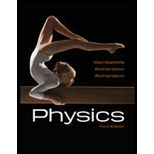
Concept explainers
(a)
The object distance.
(a)
Answer to Problem 79P
The object distance is
Explanation of Solution
Write the transverse magnification equation in terms of the object and image heights.
Here,
Write the transverse magnification equation in terms of the object and image distances.
Here,
Equate equations (I) and (II) and rewrite the equation for
Conclusion:
Given that the height of the object is
Substitute
Therefore, the object distance is
(b)
The type of the mirror used.
(b)
Answer to Problem 79P
The mirror is convex.
Explanation of Solution
The images formed by a plane mirror are upright and virtual and for point objects, the object and the image are equidistant from the mirror and lie on the same normal line. Depending on the location of the object, a concave mirror can form either real or virtual images and the images can be larger or smaller than the object. The images formed by a convex mirror are upright, virtual, smaller than the object and closer to the mirror than the object.
In part (a), it is found that the image is smaller in height than the object and it is given that the image is virtual. Also the image is upright and closer to the mirror than the object. This implies the used mirror is convex.
(c)
The focal length and the radius of curvature of the mirror.
(c)
Answer to Problem 79P
The focal length of the mirror is
Explanation of Solution
Write the mirror equation.
Here,
Rewrite the above equation for
Put equation (III) in the above equation.
Write the equation for the radius of curvature .
Here,
Conclusion:
Substitute
Substitute
Therefore, the focal length of the mirror is
Want to see more full solutions like this?
Chapter 23 Solutions
Physics
 College PhysicsPhysicsISBN:9781305952300Author:Raymond A. Serway, Chris VuillePublisher:Cengage Learning
College PhysicsPhysicsISBN:9781305952300Author:Raymond A. Serway, Chris VuillePublisher:Cengage Learning University Physics (14th Edition)PhysicsISBN:9780133969290Author:Hugh D. Young, Roger A. FreedmanPublisher:PEARSON
University Physics (14th Edition)PhysicsISBN:9780133969290Author:Hugh D. Young, Roger A. FreedmanPublisher:PEARSON Introduction To Quantum MechanicsPhysicsISBN:9781107189638Author:Griffiths, David J., Schroeter, Darrell F.Publisher:Cambridge University Press
Introduction To Quantum MechanicsPhysicsISBN:9781107189638Author:Griffiths, David J., Schroeter, Darrell F.Publisher:Cambridge University Press Physics for Scientists and EngineersPhysicsISBN:9781337553278Author:Raymond A. Serway, John W. JewettPublisher:Cengage Learning
Physics for Scientists and EngineersPhysicsISBN:9781337553278Author:Raymond A. Serway, John W. JewettPublisher:Cengage Learning Lecture- Tutorials for Introductory AstronomyPhysicsISBN:9780321820464Author:Edward E. Prather, Tim P. Slater, Jeff P. Adams, Gina BrissendenPublisher:Addison-Wesley
Lecture- Tutorials for Introductory AstronomyPhysicsISBN:9780321820464Author:Edward E. Prather, Tim P. Slater, Jeff P. Adams, Gina BrissendenPublisher:Addison-Wesley College Physics: A Strategic Approach (4th Editio...PhysicsISBN:9780134609034Author:Randall D. Knight (Professor Emeritus), Brian Jones, Stuart FieldPublisher:PEARSON
College Physics: A Strategic Approach (4th Editio...PhysicsISBN:9780134609034Author:Randall D. Knight (Professor Emeritus), Brian Jones, Stuart FieldPublisher:PEARSON





